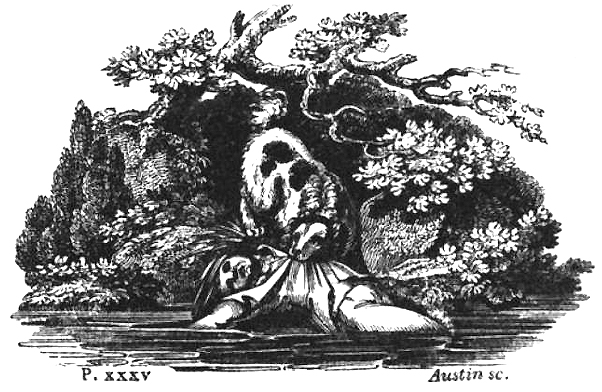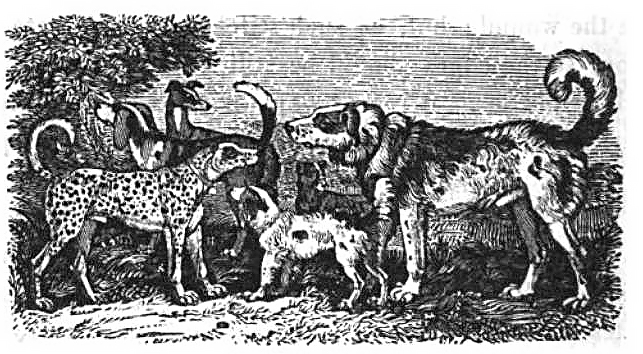[ Blaine / Canine Pathology ]
This book — the full title of which is a delightful mouthful: Canine Pathology, or a Full Description of the Diseases of Dogs; with their Causes, Symptoms, and Mode of Cure: Being the Whole of the Author's Curative Practice, During Twenty Years Extensive Experience. Interspersed with numerous Remarks on the General Treatment of These Animals and Preceded by an Introductory Chapter on The Moral Qualities of the Dog. — was first published in 1817 by T. Boosey in London. The second edition, first published in 1824, included additional remarks on the Newfoundland.
Blaine (1768–1845) was an English veterinarian, veterinary professor, author, and early advocate for a more humane treatment of domestic animals. He was the mentor and veterinary partner of William Youatt, who himself wrote several books discussed here at The Cultured Newf. A later work of Blaine's, An Encyclopedia of Rural Sports (1840), is also discussed here at The Cultured Newf.
The image immediately below is on the title page, and shows a black-and-white Newfoundland doing what Newfoundlands were even in 1817 already quite famous for.

[ About This Image: the lower right corner reads "Austin SC," with "sc" being the standard Latin abbreviation used to credit the engraver of the work. This is probably Richard Turner Austin (1781 - 1842), son of a famed typemaker also named Richard Austin, leading to much confusion, who is sometimes said to have trained as an engraver with Thomas Bewick, the noted wood engraver (whose work is discussed
elsewhere here at The Cultured Newf), although this is in dispute. Since Austin was also a painter — he exhibited at the Royal Academy — it may be that he created the original image from which this work is engraved. The left-hand corner of the image has "P. xxxv" where the painter's name is customarily found. This most likely refers to "Plate 35" ("page 35" makes no sense, as the text on that page discusses conditioning dogs for field work), since one of the subsequent images in this book is numbered 36. I do not know why the numbering would start with 35 and why only some of the images are numbered. Only one other image in this book is credited to Austin. ]
This work's first reference to Newfoundlands occurs in the Introduction, in a section in which Blaine is discussing what he refers to as a "sixth sense," an "instinctive .... "faculty of the mind" in dogs: their ability to find their way home over unknown territory at considerable distance. Blaine uses the following story of a Newfoundland to illustrate this faculty:
A gentleman brought from Newfoundland a dog of the true breed, which he gave to his brother, who resided in the neighbourhood of Thames Street; but who, having no other means of keeping the animal except in close confinement, prefered sending him to a friend living in Scotland. The dog, who had been originaily disembarked at Thames Street, was again re-embarked at the same place on board a Berwick Smack; by which means, during his stay in London, he had never travelled half a mile from the spot where he was landed. During the short time he remained, he had, however, contracted an affection for his master; and, when he arrived in Scotland, his regrets at the separation induced him to take the first opportunity of escaping, and, though he certainly had never before travelled one yard of the road, yet he found his way back in a very short time to his former residence on Fish Hill Street; but in so exhausted a state, that he had only time to express his joy at seeing his master, and expired within an hour after his arrival.
Newfs are mentioned specifically in a section on "canker of the ear," where Blane notes that "all dogs, who frequent the water much, are more particularly disposed to canker than others. Any kind of dog may have it; but Newfoundland dogs, poodles, and water spaniels, are most liable to it. Perhaps the length of hair around their ears, not only keeps these parts hot, but also retains the water within, and thus encourages an afflux of fluids or humours, as they are termed, to them." (26)
Discussing poisoning issues with dogs, Blaine agains mentions the Newfoundland:
A very common poison also is the nux vomica, or vegetable called crowfig, which produces its deleterious effects, by robbing the nervous system of all its energy in a few minutes. In a case of madness, I destroyed a very strong Newfoundland dog, in five minutes and a half, by a dram of this substance; and where it is necessary, from peculiar circumstances, to destroy a dog, this forms one of the best means. Dissection cannot detect this poison with any certainty; and, unless an emetic is given within a minute or two after the poison has been taken (provided the dose has been a full one), no benefit can arise from any medicine. The crowfig, however, proves very irregular in its action. Some dogs are hardly affected by it, while others are destroyed by a slight dose.
"Crowfig" (current botanical name Strychnos nux-vomica is the seed of a tree that grows primarily in India and the West Indies. One of the principal chemicals present in these seeds is strychnine, well-known as a very potent toxin. While strychnine was once used, in very small doses, to treat certain gastric ailments in humans, its use is now limited primarily to rat poison.
A final reference to Newfoundlands occurs in the section entitled "The Stone in Dogs," referring to kidney stones:
This, though not a very common complaint, does exist. I have not less that forty or fifty calculi by me which I took from a Newfoundland dog, after his death, which was occasioned by the obstruction of the passage of the urine by means of these stones. Death had already happened before I was called in, or probably relief might have been afforded by an operation. (162)
The image below, uncredited, appears at the end of the main section of this book (and before a brief section on "Diseases of Cats," which, not being mentioned in the title or introduction, was probably a late addition to fill out a relatively short (171 pages) book. This image is included here because the dog on the right bears a marked resemblance to the Newfoundland illustrating Thomas Bewick's A General History of Quadarupeds, which is treated separately in this section of The Cultured Newf.

Blaine adds new material in the 2nd edition (London: Boosey), first published in 1824, including one significant addition which mentions the Newfoundland.
Blaine devotes much of the Introduction to the 2nd edition to tracing out the development and genealogy of dogs, noting that Newfoundland is one of the countries that provided the root stock to develop larger breeds of dogs (28).
An incident involving a mysterious case of rabies in a Newfoundland is one of Blaine's additions to the 2nd edition:
The other case was that of a Newfoundland dog, which was constantly chained to his kennel during the day, and suffered to be at large only during the night within an inclosed yard. This dog became rabid, and, as no dog was known to have had access to the yard, it seemed to be an established certainty in the mind of his owner, that he generated the disease spontaneously. This case I also sifted with great perseverance, to elicit the truth. At length I gained, from the gardener to the family, that he remembered, one night in bed, hearing an unusual noise, as though the Newfoundland dog was quarrelling with another, but which, from the dog's confined situation, made him believe was impossible, and he therefore took no notice of the subject. He also recollected that, about this time, marks of a dog appeared in his garden, which on account of the height of the wall, surprised him; and he further remembered, that remains of hair were discovered on the wall which separated the garden from the yard where the dog was confined, but which circumstances, until strict inquiry was made, had excited no attention. About the same time, the neighbourhood, it appeared, had been alarmed by the absence of a large dog belonging to one of the inhabitants, which had escaped from confinement during the night, evidently under symptoms of disease. Here, also, a ready solution of the difficulty occurred; disposed to attribute the impression made on the relators to want of due inquiry, or to the erroneous information gained from those around. (235 - 236)


